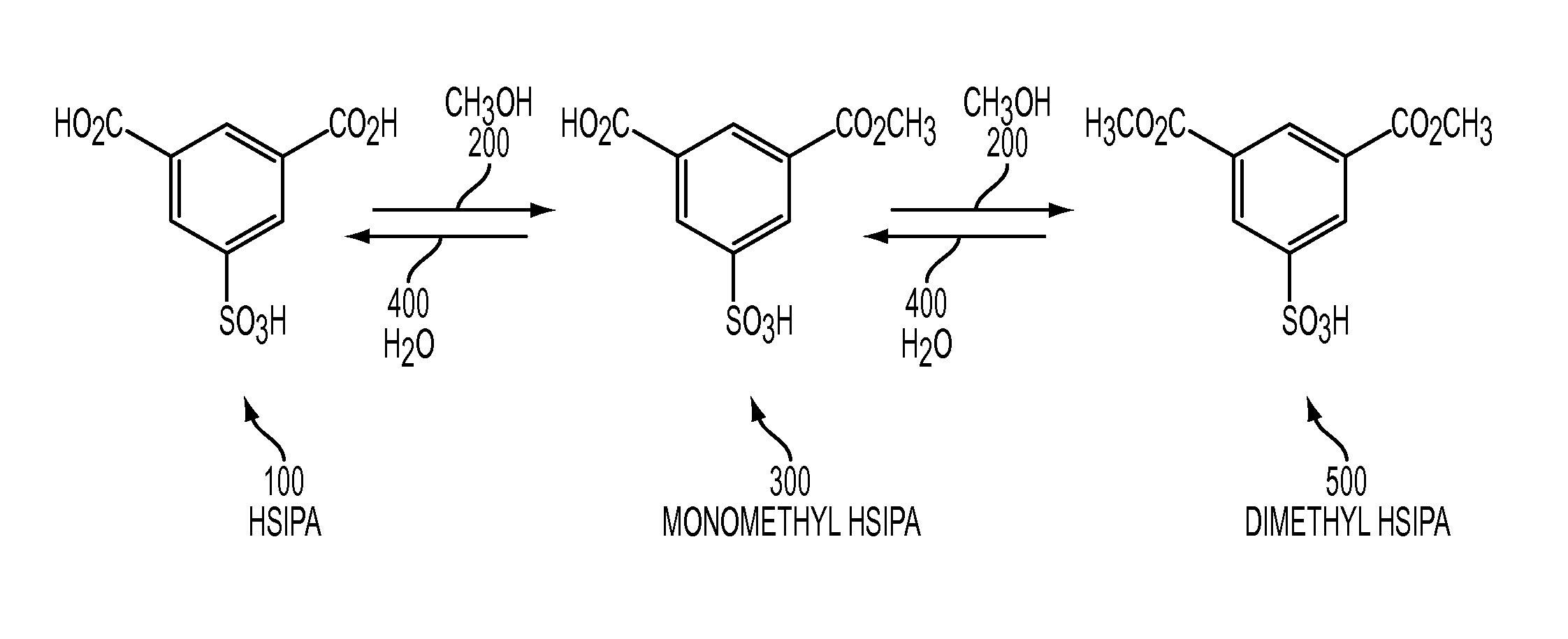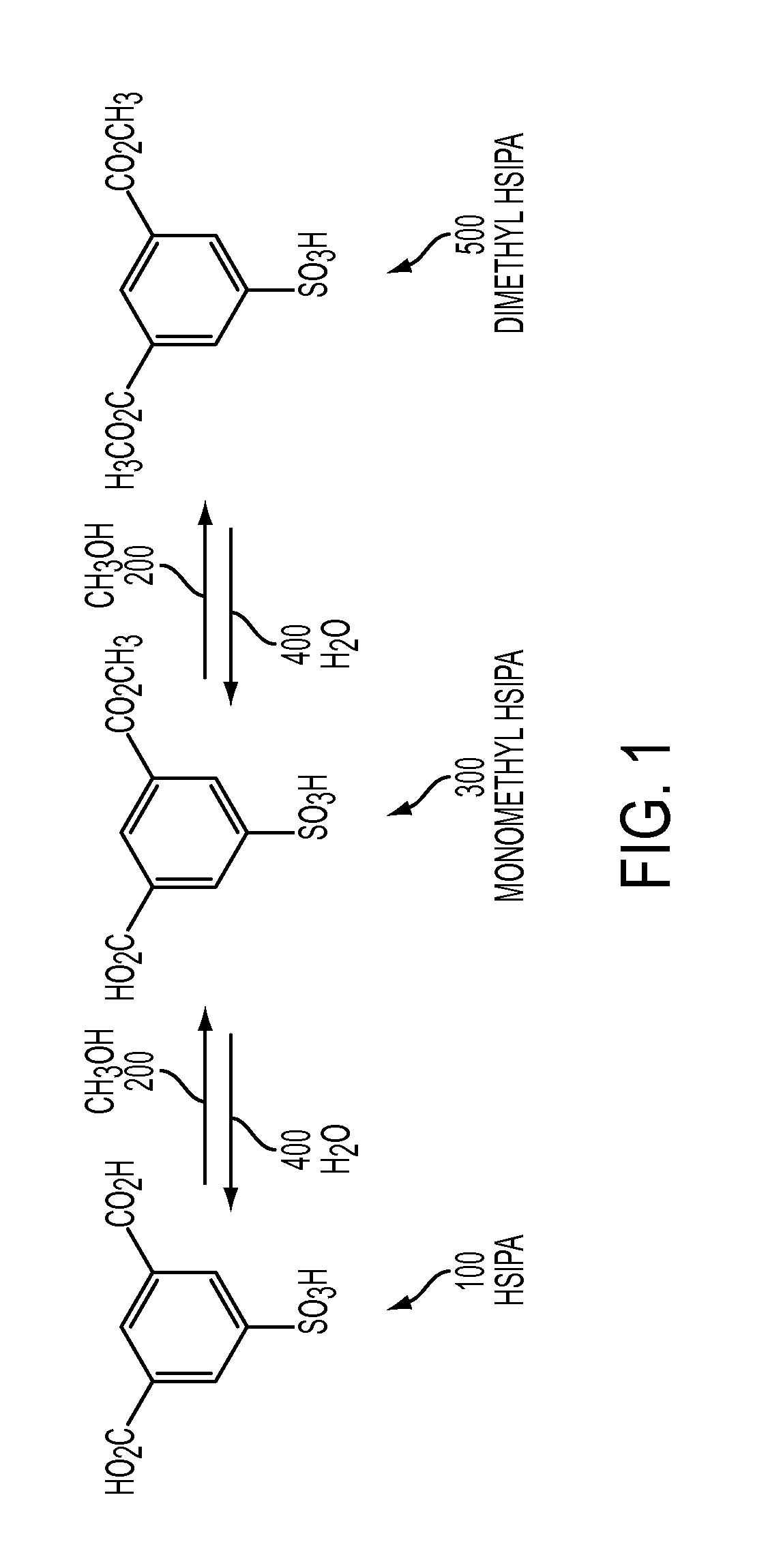Metal salts of a dialkyl ester of 5-sulfoisophthalic acid and method of preparing same
a dialkyl ester and dialkyl ester technology, applied in the field of polymer chemistry and specialty chemicals, can solve the problems of poor lightfastness, filament breakage, and under-utilization of cationic dyeable nylon as a carpet fiber
- Summary
- Abstract
- Description
- Claims
- Application Information
AI Technical Summary
Problems solved by technology
Method used
Image
Examples
example 1
[0069]Previously isolated 5-sulfoisophthalic acid (HSIPA) having the following analysis was used in this example: Total Acidity (NaOH in water)=98.2%; Water, % Karl Fisher in pyridine=0.18%; Sulfuric Acid, %=0.16%; APHA Color=71; Iron=1.25 ppm.
[0070]Into a 1000 mL round bottom flask (150) add 250 g of methanol (200) and 123 g (dry basis) of HSIPA (100). This mixture was heated to reflux (65° C.) and held at reflux for one hour. The mixture was then cooled to 20° C.-30° C.
[0071]Into a separate 2000 mL round bottom flask (250) add 300 g of de-ionized water (400), 33 g of glacial acetic acid (700), and 42 g of sodium hydroxide (50% aqueous) (600). Heat this solution to 45° C.-70° C.
[0072]Drown the solution from the 1000 mL flask (150) into the second flask (250) over 1 to 10 minutes.
[0073]Warm the resulting product slurry to 75° C.
[0074]Cool the product slurry to achieve crystallization of product (about 25° C.).
[0075]Filter the product slurry on a sintered glass funnel (275) with a va...
example 2
[0077]To a 1000 mL round-bottom flask is added 109 g of de-ionized water, 21.9 g of glacial acetic acid and 15.3 g of lithium hydroxide monohydrate. The temperature of the solution is adjusted to 70° C. Slowly, 170 g of DMHSIPA solution (56.15% DMHSIPA in methanol) at ambient temperature is drown into the aqueous solution. The solution is heated to about 79° C. and 44 g of low boilers are removed using vacuum. The solution is cooled to 25° C. and a portion of the solvent allowed to air evaporate to induce crystallization. The product slurry is filtered on a sintered glass funnel with vacuum and dried overnight in a 90° to 100° C. oven. The product analyzed as follows:
Sample 2 - Lithium SaltWeight, grams72.4DMSIPA, Area % LC98.8Monomethyl SIPA, Area % LC1.1Water, % KF0.10Sulfate, ppm as SO42−, ICAcetate, ppm as AcO1−, IC2777Strong acid, % as H2SO40Li, x-ray fluorescenceConfirmedYield, % dry weight71.6
example 3
[0078]To a 1000 mL round-bottom flask is added 209 g of de-ionized water, 21.9 g of glacial acetic acid and 75.0 g of rubidium hydroxide (50% in water). The temperature of the solution is adjusted to 70° C. Slowly, 170 g of DMHSIPA solution (56.15% DMHSIPA in methanol) is drown into the aqueous solution. The resulting slurry is heated to 77° C., held for 10 minutes and cooled to 25° C. The product slurry is filtered on a sintered glass funnel with vacuum, washed with 40 g of DI-water (0 to 5° C.) and dried overnight in a 90° to 100° C. oven. The product analyzed as follows:
Sample 3 - Rubidium SaltWeight, grams110.2DMSIPA, Area % LC98.6Monomethyl SIPA, Area % LC1.4Water, % KF0.07Sulfate, ppm as SO42−, ICAcetate, ppm as AcO1−, IC185Strong acid, % as H2SO4naRb, x-ray fluorescenceConfirmedYield, % dry weight88.2
PUM
| Property | Measurement | Unit |
|---|---|---|
| temperature | aaaaa | aaaaa |
| temperature | aaaaa | aaaaa |
| temperature | aaaaa | aaaaa |
Abstract
Description
Claims
Application Information
 Login to View More
Login to View More - R&D
- Intellectual Property
- Life Sciences
- Materials
- Tech Scout
- Unparalleled Data Quality
- Higher Quality Content
- 60% Fewer Hallucinations
Browse by: Latest US Patents, China's latest patents, Technical Efficacy Thesaurus, Application Domain, Technology Topic, Popular Technical Reports.
© 2025 PatSnap. All rights reserved.Legal|Privacy policy|Modern Slavery Act Transparency Statement|Sitemap|About US| Contact US: help@patsnap.com



